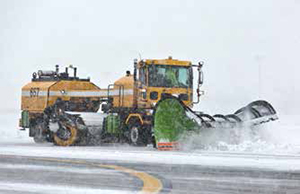Airports Turn to Equipment Vendors for Crew Training & Maintenance

As snow removal equipment continues to become more sophisticated and complex, more airports are relying on manufacturers to help train their crews to operate and maintain it. Some are even contracting equipment makers to perform major repairs for them.
A good example of this trend is unfolding at Indianapolis International Airport (IND), which invested about $6 million in nine multifunction snow removal machines several years ago. As part of the purchase agreement with M-B Companies, IND required the vendor to provide seven days of comprehensive operations and maintenance training instead of the usual two days.
IND's desire for more training reflects an ongoing evolution from conventional, single-function vehicles that blow, plow or sweep snow off runways to multitasking machines that can perform all three functions. Increased functionality dramatically improves snow removal efficiency, but also poses training challenges, explains Mike Medvescek, senior director of operations and public safety at IND. Technological advancements in electronic, hydraulic and computer systems are driving many of the equipment improvements, and some staffs are simply not equipped to troubleshoot and maintain the new systems.
|
facts&figures Project: Snow Removal Equipment Training & Maintenance Location: Indianapolis Int'l Airport Location: Denver Int'l Airport |
In terms of removal efficiency, IND crews now use nine M-B5s to clear runways instead of 18 machines, which significantly improves operator safety. In addition, clearing time is down from 18 to 20 minutes per runway to 12 minutes. "It's been a huge improvement," reports Medvescek. "In fact, we haven't had to close a runway for the last couple of years because this equipment is so effective."
While removal crews were spending less time clearing the airfield, IND mechanics were spending more time maintaining and repairing the newer, more complicated machines. That made it difficult to maintain the airport's other 500 pieces of rolling stock-everything from lawn mowers and tractors to backhoes, pickup trucks and shuttle buses.
To resolve the problem, the airport contracted M-B Companies to perform all major repairs on its multifunction vehicles, freeing up IND mechanics to keep the airport's snow blowers, plows and other equipment up and running. "If we're in the middle of a snow fight, we can't afford to have our mechanics tied up for two days on a major repair," Medvescek explains. "It helps us keep our smaller units out on the road. It's all about how well we can manage our mechanics' time."
Airfield crews use the fleet of M-B5s to clear about six miles of runway and 12 miles of taxiways, while other workers use 21 pieces of conventional snow removal machines to clear ramp areas and roadways.
Expediency & Efficiency
During the seven days of manufacturer training, IND mechanics not only received instruction about maintaining the airport's new multifunction equipment, they also learned how to operate it. Why? Because when something goes wrong out on a runway, for example, mechanics must be able to communicate effectively with equipment operators via radio or cellphone to access on-screen diagnostic information.
"If a mechanic knows how to operate the equipment as well as repair it, he can troubleshoot more effectively," Medvescek points out. "Moreover, they might be as much as two miles apart. So if troubleshooting by radio works, the mechanic knows in advance what tools to bring out to the runway. That's more efficient than going all the way out, then having to go back to the shop [for] the right tools or parts."
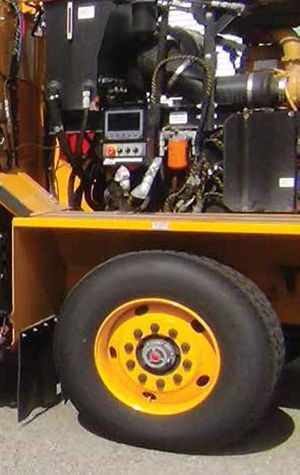 IND's contract also requires the manufacturer to perform regular equipment inspections and updates to optimize performance and prolong the fleet's lifecycle. "M-B Companies comes in after the snow season, plugs in their computers and updates the software...and also make suggestions for what should be replaced or repaired," Medvescek explains. "They're the pros-they know their equipment better than anyone and can address issues much quicker than our mechanics."
IND's contract also requires the manufacturer to perform regular equipment inspections and updates to optimize performance and prolong the fleet's lifecycle. "M-B Companies comes in after the snow season, plugs in their computers and updates the software...and also make suggestions for what should be replaced or repaired," Medvescek explains. "They're the pros-they know their equipment better than anyone and can address issues much quicker than our mechanics."
When a major breakdown occurs after warranty coverage expires, IND pays the manufacturer on a per-job basis to send repair technicians to the airport. Because M-B Companies' airport products division is located in Wisconsin, about 350 miles from IND, mechanics can usually arrive the same day and either bring parts with them or have them shipped overnight.
That may sound like an expensive arrangement, but not when measured against the cost of closing the airport because the runways can't be cleared. "What's the cost of that compared to having someone come down quickly and get things up and operating?" Medvescek asks. Moreover, he considers it more cost-effective to have a manufacturer's technician repair a machine quickly than have an airport mechanic occupied for days.
"Our goal is to give our mechanics an opportunity to keep 100 percent of everything else up and running," Medvescek says.
It's Complicated
IND's response to dealing with increasingly complex machines reflects a larger trend, says Steve Karlin, vice president and general manager of M-B Companies. Some airports need extra help because they're short-staffed. At other airports, especially smaller facilities, personnel simply can't keep up with all the new technology. "You might have a guy who cuts lawns and maintains a snow plow in winter," he points out.
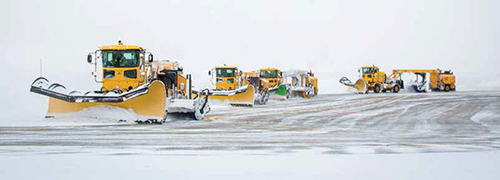 Often, financial constraints prevent airports from replacing knowledgable veteran mechanics when they retire. "That's a very visible trend right now," reports Karlin. "The labor force at some airports just isn't what it used to be."
Often, financial constraints prevent airports from replacing knowledgable veteran mechanics when they retire. "That's a very visible trend right now," reports Karlin. "The labor force at some airports just isn't what it used to be."
Then there's the complexity of the equipment itself. "Airport snow removal equipment has evolved just as much as your personal automobile," says Matthew McKibbin, an agency trainer at Denver International Airport (DEN), which also is partnering more extensively with manufacturers for equipment training. "And just like today's automobiles, this equipment utilizes computer-controlled components that work together on computer area networks to maintain emissions standards and optimal implement performance."
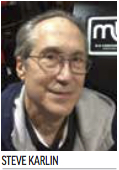
To better understand the complexities of repairing newer machines, consider a typical older truck-mounted broom sweeper. To swing the broom, the operator pulls a handle that, in turn, pulls a cable that opens a valve, releasing oil for the hydraulic system. "When you release the handle, it goes back to a neutral position and the oil stops flowing," Karlin explains. "The (broom) head moves hydraulically, but it relies on a mechanical cable to pull the valve and allow oil to flow-kind of like a physical extension of your hand."
In newer machines, components such as engines, transmissions and hydraulics are all electronically controlled. As such, if an operator pulls the handle and nothing happens, fixing it is far more complicated than simply checking a cable or hydraulic line.
"Now, the handle in the cab and the hydraulic valve on the back of the truck are connected by an electric wire, with a solenoid on the valve," Karlin says. "So instead of just one thing going wrong, it could be three or four different things, like the electrical connection, the solenoid or the joystick itself. We provide on-board diagnostics to help them troubleshoot, but the mechanics often forget how to use them in the off-season."

Moreover, today's engines feature sophisticated electronic controls in order to meet federal emission standards. As such, all of a machine's components must be able to communicate with the engine. "Once the engine is electronic, we have to match it with electronic controls so they can talk to each other," he says. "There's no longer such a thing as a mechanical truck."
Hybrid Approach
At DEN, officials combine manufacturer training with their own in-house curriculum. "Typically, the process involves annual vendor training for our operators and repair technicians, which then is included in our operating/repair policies and procedures that we teach throughout the year," McKibbin says.
While annual vendor training for most equipment is free, training for more specialized equipment is not. Last year, DEN used $15,000 from general revenue funds to pay for extra training.
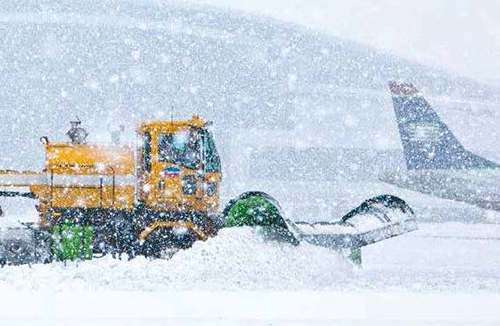
The airport schedules five weeks of vendor training for equipment operators during their off-season, in September and October. Classes range from two to eight hours each, depending on the equipment. These sessions complement an additional 40+ hours of yearly in-house training, McKibbin notes.
"A highly trained staff offers many benefits, such as reduced maintenance costs, faster vehicle turn-around times and more efficient snow removal," he explains. "In fact, we have one of the quickest snow-removal times for cleaning a runway in the country-about 12 minutes. With good training, everybody wins, especially the airlines and our passengers."
In addition to clearing six runways and more than 90 million total square feet of airside pavement, crews at DEN also maintain 300 lane miles of landside roads and 30 acres of parking lots. During snowstorms, more than 430 employees are deployed each day for various snow removal duties, McKibbin reports.
Given its high traffic volume as one of the busiest U.S. airports and its snowy local weather, DEN maintains a large inventory of removal equipment: 250 pieces for clearing the airfield and 120 machines for landside maintenance. Its fleet includes blowers, brooms, blades, plows, runway sanders, snow melters, chemical trucks, loaders with box plows and skid-steers.
Future Outlook
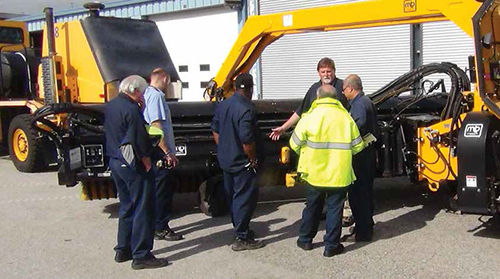
It's difficult to predict how far the trend toward more vendor training and repair support will evolve. But one thing is certain: It's an attractive proposition for airports trying to cope with staffing constraints and tougher snow removal standards (see sidebar).
Karlin's take is this: "If you used to have 20 guys to maintain equipment and plow runways five years ago and now have 14, and the FAA is raising standards about how clean your runway needs to be, it affects your operation. When you have fewer resources to do a bigger job, the main question airports will be facing is how the hell to get the job done.
"On the other side of the equation, the equipment is much more complicated and most airport mechanics only work on them for three or four months a year," he continues. "So in the middle of a snow storm, how do they repair equipment in a timely manner?"
Karlin acknowledges that more involvement from equipment manufacturers isn't a good fit for every airport, but it works well for a growing number of facility operators. "Indy and Denver are two airports that, in their own ways, are really into it," he says. "They're very conscientious about doing what they tell the public they're going to do-keep airports open and safe."
|
New Runway Reporting Requirements The new reporting standards include codes designed to help aircraft operators, pilots and flight planners more accurately determine how much distance is needed to stop on a wet or contaminated runway. Released in October 2016, the guidelines were developed by an FAA aviation rulemaking committee that was formed after a jet skidded off a runway at Chicago Midway International Airport in December 2005. The plane hit several cars and killed a 6-year-old boy. "The [committee] determined that the industry needed to communicate actual runway conditions to the pilots in real time and with information that would accurately correlate an expected aircraft braking performance," explains Carl Braley, assistant airport director at snow-prone Manchester-Boston Regional. The new system uses a scale of one to six to convey runway conditions-with six indicating perfectly dry pavement. The worse conditions are (snow depth and compaction, for instance), the lower the assessment code. "Zero is not a reportable code. At that point, the runway would be closed," notes Braley, who recently explained the new reporting requirements during a Snow Academy class at Roanoke-Blacksburg Regional Airport. (Snow Academies are an extension of the annual NEC/AAAE International Aviation Snow Symposium.) To determine a runway's condition code, airport personnel input data such as pavement type, depth and type of surface contamination, ambient temperature, etc. into a web-based software program. The program then computes the data and provides a condition code for the airport to communicate to pilots. In the past, runway condition reports included a braking co-efficiency that used a numerical code called a Mu number (a measurement of drag and deceleration determined by a device called a decelerometer.) Airports were responsible for determining Mu values for the touchdown, midpoint and rollout areas of their runways to provide pilots with information about how much brake to apply while landing. "The basic problem was that the Mu number did not directly correlate the performance for different kinds of aircraft at different airports," Braley explains. "In other words, a report of 40 at one airport, for example, could be different than a report of 40 at another airport, due to different kinds of equipment used and subjective scoring by the operators."
The new condition codes are designed to correct those shortcomings. For more information, visit www.faa.gov and search for "new TALPA requirements." The new assessment system will also be explained at Snow Academy classes during the Snow Symposium in Buffalo (April 22 to 26) and at subsequent Snow Academy classes held around the country. For details, visit www.snowsymposium.org/attend/i-a-s-s-snow-academy or www.aaae.org. |
FREE Whitepaper
Fairbanks International Airport Baggage Transport Conveyor Enhanced With Mod Drive™ System
Airports face a host of unique industry challenges, such as meeting efficiency regulations and seeking out the best maintenance practices to reduce costs and keep operations flowing. In today’s current economic climate, any potential cost savings can go a long way.
In 2019, Alaska’s Fairbanks International Airport (FAI) sought to modernize its equipment and operations. They were dissatisfied with the performance of the gearmotors on their baggage transport conveyors and began searching for new suppliers. Regal approached FAI with a solution that could improve equipment performance and simplify maintenance, with the added benefit of energy cost savings: the Hub City® MOD Drive™ system.
This white paper discusses the hardware deployed, the test results and the annualized expectations for ROI.

